Human Chromosomes - PowerPoint PPT Presentation
1 / 24
Title: Human Chromosomes
1
Chapter 2 Human Chromosomes DNA content DNA
content of cells (ploidy, cell cycle,life
cycle) C (DNA content) n (haploid number) C for
humans 3.5 x 10-12 g n 23 all mammals are
diploids In mitosis 2C (before S phase) -------gt
4C (after S phase) In meiosis 2C (before S
phase) ------gt 4C (after S) ---- C 4 haploids
---- C ----
C ---- C
2
Development - fertilization ---gt cell division
---gt differentiation --gtmorphogenesis ----gt
programmed cell death (apoptosis) -
X-inactivation (Lyonization) occurs in human
females. - is a means of dosage cpompensation at
the last blastocyst stage - inactivate all X
chromosomes except one - for X-linked genes,
males are constitutionally hemizygous while
females are functionally hemizygous. - Inactive
X chromosome forms a Barr Body
3
(No Transcript)
4
Structure functions of chromosomes - human or
any eukaryotic chromosomes only require 3 classes
of DNA sequences - centromeres - telomeres -
origins of replication - packaging of DNA into
chromosomes requires several levels of folding
5
(No Transcript)
6
- Centromeres are a primary constriction in the
chromosome - Origins of replication (using yeast
plasmid to trap promoters) - Telomeres -
maintain the structural integrity of chromosomes
- guarantees complete replication of chromosome
ends - establish the cytoskeleton of the nucleus
7
(No Transcript)
8
Heterochromatin (genes not expressed) Euchromatin
(genes may be expressed)
9
Mitosis Meiosis Mitosis
10
(No Transcript)
11
Meiosis - independent assortement of paternal
maternal chromosomes 223 8.4 x 106
combinations - X-Y pairing at pseudoautosomal
region 2.6 Mb at tips of short arms (obligatory
recombination 320 kb at tip of long arm (no
obligatory recombination genes in
pseudoautosomal regions do not show X-linked
pattern of inheritance and are not subject to
X- inactivation
12
(No Transcript)
13
(No Transcript)
14
(No Transcript)
15
(No Transcript)
16
Human chromosomes - best seen in lymphocytes -
chromosomes identified by centromere position and
banding pattern
17
(No Transcript)
18
(No Transcript)
19
Chromosome abnormalities Most caused by -
miss-repair of broken chromosomes - improper
recombination - malsegregation of
chromosomes during mitosis or
meiosis Types - polyploidy (triploid) -
aneuploidy (monosomic and trisomic -
structural - chromosome breaks lead to
deletion, insertion, inversion and translocation
20
(No Transcript)
21
(No Transcript)
22
(No Transcript)
23
(No Transcript)
24
(No Transcript)































